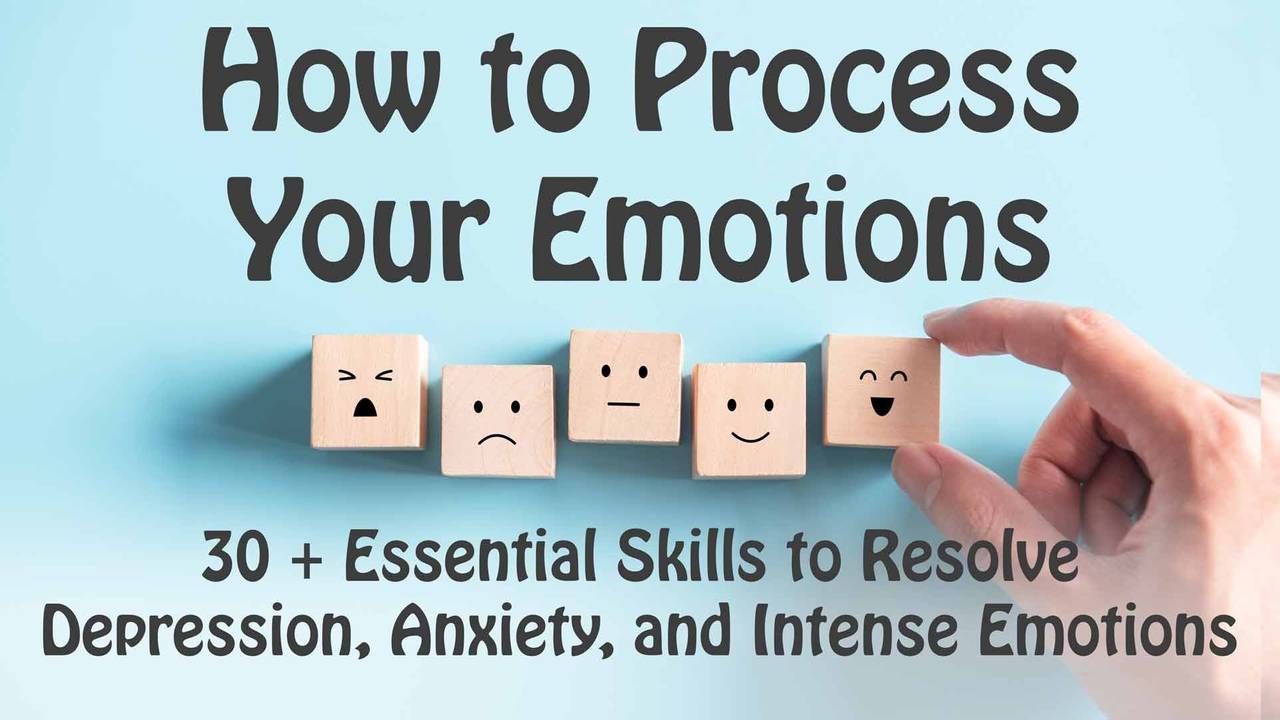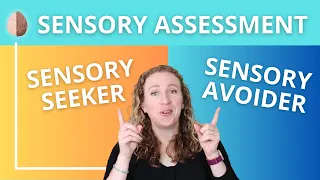Are you aware of your sensory needs? Are you a seeker or avoided? Here’s a Sensory Needs Assessment that you can download: https://courses.therapyinanutshell.com/pl/2148296708
Have you ever found yourself feeling overwhelmed, irritable, or simply drained by your surroundings? It’s not uncommon to experience these emotions, especially in a world that’s constantly buzzing with activity and stimuli.
But what many people don’t realize is that these feelings could be closely tied to our sensory needs. Understanding and acknowledging our unique sensory preferences is like discovering the secret code to feeling more comfortable and at ease in our daily lives.
In this video, we’ll explore what your specific sensory needs are in each of 6 sensory areas, and we’ll talk about how you can adapt to them. Because this can help you regulate your emotions and improve your mental health.
So, let’s jump in.
Disclaimer
OK, first a disclaimer, this is not an official psychological assessment. You should always work with your individual providers as you explore what your individual needs are. An Occupational Therapist or a Mental Health provider skilled in sensory processing disorders can help you get tailored interventions.
That being said, we all know that you can learn a ton from the internet, and this is one of those cases. We aren’t diagnosing you with anything, we’re just exploring what your sensory needs might be so that you can adjust your actions and environment to help yourself be more relaxed and regulated throughout the day.
6 Main Sensory Needs Areas
We’re going to explore 6 main sensory needs areas. With each item, you can evaluate whether you are a sensory seeker, sensory avoider, or neutral. Then we’ll talk about a few ways that you can adapt to meet your needs. Again- if you’d like to learn more, there’s a bunch of great books out there that go into more detail about how to accommodate these sensory needs. For one- “A buffet of sensory interventions” is great.
With each of these items check to see if you seek out those experiences, avoid them, or it’s mixed or neutral. Use little tally marks in a chart like this.
Sense | Seek | Avoid | Neutral/Mixed |
Touch | |||
Proprioceptive | |||
Vision | |||
Taste and Smell | |||
Vestibular | |||
Auditory |
OK, #1. Touch-
- Physical Contact hugs, cuddles, snuggling, handshakes, pats on the back, physical sports like wrestling or roughhousing.
- Do you enjoy or seek out extreme temperatures on your skin like cold air on a winter’s day or the heat from a sauna
- Textures– do you love rough canvas clothing or lots of jewelry or blankets, or textures like satin or silk? Or do you avoid intense textures and seek things that are always soft or consistent?
- Messy Play– activities that involve touching and exploring various textures like lotions, touching slime, sand, play-dough, finger painting, doing the dishes, working in the dirt
- Touching stuff all the time, fidgeting, feeling the texture of walls or objects
- Grooming– combing your hair, washing your face, feeling a shower, touching your hair, skin or nails frequently, getting toweled dry
- Deep pressure– massages, hugs, or being squeezed between cushions? Preference for tight fitting clothing is sensory seeking, preferring loose clothing is sensory avoiding.
- Difficulty Concentrating Without Tactile Stimulation- like rubbing a textured object or tapping their fingers.
- Surprise touches– bumping into someone at a concert, being tickled, being in a crowded subway.
- The feeling of certain food textures or temperatures- some people seek exciting combinations of food textures- like sushi or chips, others avoid textures and limit what to eat to consistent textures like bread.
#2. Proprioceptive (Body Sense)
- Physical Play like roughhousing, wrestling, or playfully crashing into soft objects.
- Jumping or Bouncing
- Pushing Against Surfaces: like walls, doors, or furniture to obtain deep pressure.
- Active Participation in Sports: They may be drawn to sports and activities that involve physical contact, such as football, rugby, or martial arts.
- Enjoyment of Weighted Items: like weighted vests or lap pads.
- Difficulty Sitting Still or fidget or shift positions frequently to seek proprioceptive stimulation.
- Having Eyes closed or covered
- Squeezing: Like stress balls, tight hugs, or squeezing between cushions.
- Heavy Work or effort like carrying heavy objects, pushing or pulling heavy furniture, or climbing. Manual labor.
- Tactile experiences that provide deep pressure, such as rolling on a foam roller, getting a massage, or lying under a weighted blanket. frequently manipulate objects, like twisting or squeezing a pen, to satisfy their need for proprioceptive input.
#3. Vision:
- Looking at shining, spinning or moving objects, enjoying fairy lights, christmas lights or sunlight streaming through windows. Lava lamps, pinwheels.
- Looking for objects- rockhounding, birdwatching, seek and find activities, observing nature,
- Making or Experiencing Art- art museums, drawing painting or coloring
- Reading for long periods of time
- Busy visual environments- whether that’s having lots of pictures on your walls or enjoying window shopping at the mall.
- Visual puzzles- jigsaw puzzles or spot the difference games, optical illusions
- Visual Variety- Do you favor bright, vibrant colors in clothing, toys, or do you prefer a minimalist environment
- Busy, bright, action packed TV, Movies, or video games
- Eye contact
- Attention to Detail
#4. Taste and smell: do you seek or avoid:
- Unfamiliar Scents- Lotions, candles, perfumes,
- New Tastes- Do you like to eat new and exciting foods
- Intense Flavors- like spicy, salty, bitter, sour, etc.
- Strong Odors- like gasoline, cleaning supplies, plastics,
- New or exciting food textures- slimy sushi, popping boba, crunchwrap supreme, pop rocks,
- Natural smells- rain, strong evergreen smells, etc.
- Highly flavored food:
- Do you seek to eat a large variety of foods or eat the same few foods over and over?
- Exoctic or foreign foods
- Food with lots of different flavors- salty caramel, lemon salmon, do you use a lot of different spices in cooking.
# 5. Vestibular: Do you seek or avoid:
- Swinging-
- Spinning- toys, merry go rounds, the tea cup ride, spinning chairs
- Wild or fast rides, fast transportation,- roller coasters, changes in direction when driving fast, thrill seeking in a movement way-
- Tumbling, Gymnastics, Flips,
- Movement in general- Riding in a car, elevators, escalators,
- Rocking- rocking chairs, hammock, or swings, or rocking in their seat, leaning their chair back.
- Heights- climbing, looking out windows of skyscrapers,
- Balancing- Riding a bike, balancing on a log, walking on uneven ground, skateboarding
- Jumping- on trampolines or off a bench or diving board
- Getting upside down- head stands, inversion tables, cartwheels, handstands
#6. Auditory
- White noise, background music, fans or dishwashers running
- Noisy settings – coffee shop, crowded restaurant, parties
- Loud music, concerts, loud speakers, straight piped cars.
- Noise making- humming, tapping, clapping, or singing spontaneously
- Creating music- singing, playing instruments
- Feedback sounds- chimes when you complete a task, notifications on your phone, beeping of a microwave when it’s done.
- Rhythm- drumming, tapping, patterns, echoes
- Exploring sounds- making echoes, booms, etc.
- Exciting sounds- unexpected sounds, Noisy toys, loud TV’s, fire alarms,
- Dance or vibrations- subwoofers, vibrating massage chairs, humming bridges,
Sense | Seek | Avoid | Neutral/Mixed |
Touch | |||
Proprioceptive | |||
Vision | |||
Taste and Smell | |||
Vestibular | |||
Auditory |
OK, so now take a look at your little chart- do you have any areas that you are strongly seeking or avoiding? Let’s explore what types of changes we can make to your environment to help you be more regulated:
You can use the chapters in the description to jump to the sections you need. One thing to note- we all have a sensory comfort zone, a stretch zone and a panic zone. It’s ok to spend periods of time in our stretch zone, we might just need breaks to go back into our comfort zone to relax and recover afterwards. We don’t want to get too focused on avoidance, because that can shrink our comfort zone. Our goal is to create a sensory diet that helps us function in our lives. So as you explore these accommodations, don’t get sucked into too much avoidance, try to find a balance that supports you in living the life that you desire, even when at times that is uncomfortable, by taking time to stretch and then rest and recover afterwards.
And again, individuals with specific needs can benefit from working with a skilled Occupational therapist who specializes in sensory accommodations.
If You’re A Touch Seeker
- Get tactile sensory tools like fidget toys, textured objects, or sensory balls to play with or explore.
- Create opportunities for physical play, such as wrestling, hugging, or playfully crashing into soft objects to satisfy their need for touch.
- Use Weighted Blankets or vests, which can provide deep pressure and tactile input.
- Use clothing and bedding made from sensory-friendly materials, such as soft cotton or fleece, to enhance tactile comfort.
- Incorporate scheduled sensory breaks that include hugs, squeezes, or gentle massages to fulfill their touch-seeking tendencies.They could also use a back scratcher, or massage ball, foam roller or massage gun. This is why a lot of people like pets, you can get some physical touch.
For A Touch Avoider
- Ask people to respect your personal space in an assertive way. Let people know if you prefer a handshake over a hug.
- For parents, teachers or family members- respect the individual’s need for personal space.
- Make contact more predictable. Ask people if it’s ok to give them a hug. Provide warning when physical contact is about to happen and give the individual time to prepare or decline. Ask them how they like to be touched. Many touch avoiders don’t like a light or glancing touch, but they may like a firm consistent, predictable touch. Temple Grandin made herself a hug machine to meet her needs.
- Explore clothing options- many touch avoiders prefer clothing made from soft, non-irritating fabrics. They might not like tags, belts, dangly things, they might not prefer to have their hair down. They may prefer loose fitting or stretchy clothing.
- Design work environments where you can have a little more space and take breaks as needed. Sit on the edge of rows, move your desk a bit away from others. Designate quiet zones in offices.
Proprioceptive Seeker
- Provide Heavy Work Activities like lifting, carrying, or pushing objects to provide deep proprioceptive input. You may prefer a job that includes more manual labor, or you may just need breaks to exercise, walk, or work physically before your workday, at lunch or after work.
- Use Weighted Items: Weighted blankets, vests, or lap pads to provide a calming and grounding proprioceptive sensation.
- Deep Pressure Tools: Like massage, squeezing stress balls, or using compression clothing.
- Engage in Sensory Play: use materials like clay, playdough, or putty to engage the muscles and joints for proprioceptive input.
- Implement structured daily routines that involve physical tasks,
When I was in Grad school and even now in my work, I work for an hour, then go for a walk, I’ll sit for an hour, then go work in my garden. Getting physical labor is essential for me to feel regulated. My ideal job- if I had to work 40 hours a week would be 20 hours of therapy and 20 hours of landscaping.
For A Proprioception Avoider
- Respect Personal Boundaries: Educate others about the individual’s need for personal space and boundaries, and ensure that these boundaries are respected.
- Use gentle, non-intrusive touches or gestures when necessary to minimize unexpected proprioceptive input.
- Provide flexibility in participation in physical activities and allow the individual to opt-out or modify activities that involve proprioception.
- Let people know ahead of time when there’s going to be a change- ie when the car is going to start moving, when the elevator is being engaged,
- Offer comfortable and supportive seating options that allow the individual to sit in a way that minimizes unwanted proprioceptive input.
For A Visual Seeker
- Provide visually stimulating materials and activities, such as colorful artwork, kaleidoscopes, or sensory light projectors. Use interesting presentations, visual calendars, and physical visual trackers
- Use visual timers or countdown clocks to support time management and transitions between activities.
- Create visual schedules or charts with colorful and engaging visuals to help the individual understand and follow daily routines.
- Set up work or study spaces with colorful and visually appealing decorations or supplies to enhance engagement.
- Use a visual reward system using charts or tokens with bright and attractive visuals to reinforce positive behavior.
For A Visual Avoider
- Create calm and visually neutral spaces with minimal decorations and soft, muted colors to reduce sensory overload.
- Minimize visual clutter and distractions by organizing and decluttering living and working areas.
- Use curtains, blinds, or window coverings to control the amount of natural light and outdoor visuals entering the space.
- Implement visual schedules and supports that are simple and easy to follow, using plain and unobtrusive designs.
- Offer sunglasses or tinted glasses for outdoor activities to reduce glare and brightness.
- Experiment with screen filters or apps that can reduce the intensity of bright screens when using electronic devices.
For A Taste And Smell Seeker
- Provide a wide range of foods with different flavors, spices, and seasonings to satisfy their craving for diverse taste experiences.
- Encourage Cooking and Food Preparation to engage their sense of taste and smell and encourage exploration of different ingredients.
- Create sensory-friendly dining environments that are well-lit, comfortable, and free from distracting or overwhelming odors.
- Use essential oils or aromatherapy diffusers to introduce pleasant scents that align with the individual’s preferences.
- Encourage trying new cuisines and dishes to provide novel taste and smell experiences.
For A Taste and Smell Avoider
- Respect the individual’s food preferences and sensitivities, avoiding foods or ingredients they dislike or find overwhelming.
- Choose dining settings that are quiet and free from strong odors to minimize sensory discomfort during meals.
- Serve foods with milder and less intense flavors to reduce the likelihood of sensory overload. Allow groups to mix in their own sauces, spices etc. so that some can have it spicer and others can have it plainer
- Clearly label foods and ingredients to help the individual make informed choices and avoid unwanted tastes and smells.
- Offer foods with a variety of textures to accommodate their sensory preferences for mouthfeel. For example, I don’t like squash in soups or baked, but I do like it in breads or cookies.
- They may have a limited diet, incorporate nutrients into predictable foods, like blending them into smoothies or “hiding veggies” in muffins
- For kids with extremely limited diets, an OT can help you learn how to help them eat more variety of foods.
For A Vestibular Seeker
- Provide Access to Swings or other swinging equipment to satisfy the individual’s need for swinging motion.
- Create opportunities for active play, such as jumping on trampolines, climbing structures, or engaging in sports that involve movement and balance.
- Use sensory swings, such as platform swings or cocoon swings
- Allow scheduled movement breaks during the day to support the individual’s need for vestibular stimulation.
- Provide spinning toys or equipment like spinning chairs, merry-go-rounds, or Sit ‘n’ Spins, yoga balls or wobble seats to sit on.
For A Vestibular Avoider
- Create quiet and low-stimulation spaces where the individual can retreat to when feeling overwhelmed by vestibular sensations.
- Minimize exposure to fast and intense movements, such as roller coasters or spinning rides- do alternate activities.
- Encourage participation in gentle movement activities like slow rocking, swaying, or yoga to provide controlled vestibular input.
- Offer Warnings before activities that involve rapid or intense motion to allow the individual to opt-out if desired.
- Offer stability aids like handrails or balance aids to provide support during activities that challenge balance.
- May need extra support like anti-nausea medication.
Auditory Seeker
- Use White noise or music in the background
- Work in a louder environment like a coffee shop or restaurant
- Take breaks to use musical instruments or listen to music.
- Use Music breaks
- Schedule in moments to get lots of musical stimulation- go to concerts, listen to music loudly in your car, go sing karaoke, etc.
- Practice a musical instrument
Auditory Avoider
- Use Noise-Canceling Headphones or earplugs to block out unwanted sounds in noisy environments, especially when you need to do deep work.
- Find or make quiet spaces-Work in a library, a back office, or use room dividers, curtains, or soundproofing materials to create quieter zones within shared spaces.
- Allow the individual to control the volume of electronic devices, such as TVs, radios, or computers, to ensure they are at a comfortable level.
- Invest in noise-canceling devices for the home, such as white noise machines, to mask or dampen disruptive sounds.
- Provide Warning Signals: Use visual or text-based alerts to signal when loud or sudden noises are about to occur, allowing the individual to prepare or take measures to reduce their exposure.
- Flexible Schedules: Allow flexibility in daily schedules to avoid peak noise times or environments when possible.
- Put up signs telling people about your need for quiet, or why you keep your office door closed.
OK, I hope you found this little quiz helpful, if you’d like to learn a little more about incorporating a sensory diet- click here.
If you want to check out my course on How to Process Emotions, click below.





